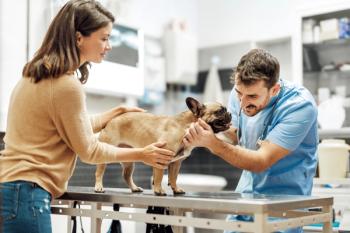
NYC practice fights back after New York Post gaffe
New York City - The phones started ringing at Riverside Animal Hospital shortly after the New York Post published a story about a Bulldog that died from respiratory distress after being left unattended for days in a veterinary clinic's kennel.
NEW YORK CITY — The phones started ringing at Riverside Animal Hospital shortly after the New York Post published a story about a Bulldog that died from respiratory distress after being left unattended for days in a veterinary clinic's kennel.
The calls and emails that followed were described as nothing short of obscene, according to clinic staff at Riverside Veterinary Group. Most were anonymous, but long-time clients were upset, too.
"She just ripped us a new one, basically," explains Andrea Conway, practice manager for Riverside Veterinary Group, which is made up of the three practices owned by Dr. Phillip Raclyn and Dr. Steven Kasanfosky. Two are in Manhattan and one is in Yorktown Heights, N.Y.
Damage control: Raclyn is defending his practice, Riverside Animal Hospital, after a popular newspaper wrongly identified it as the clinic where a kenneled Bulldog died.
But the bigger problem for the staff at Riverside Veterinary Group is that the Bulldog cited in the New York Post story was never its patient. He was boarded and died at Riverside Animal Clinic, which Raclyn sold to Dr. Javier Ramos in the 1980s.
The story ran in the July 23 edition of the New York Post on Page 3 including a photo and address of Riverside Animal Hospital.
But just days before the story was published, Marie Moore filed suit in Manhattan Supreme Court against Ramos, alleging he left the dog unattended in the clinic's kennel. The dog died, and Ramos attributed the cause of death to congestive heart failure, the lawsuit alleges. A necropsy performed by Cornell University's Animal Health and Diagnostic Center found the dog's heart in normal condition, but its death was caused by severe laryngeal edema caused by an airway obstruction and suffocation, the lawsuit alleges.
By that afternoon, Conway alerted the New York Post, which corrected the online version of its story and ran a correction, on Page 6, the following day. But, for Riverside Animal Hospital, the damage had been done.
"The feeling is really helplessness more than anything else," says Raclyn. "I know, in the real world, people like me have very little power. We're all just pawns in the game. I just felt helpless, and I knew I would never get the New York Post to do anything constructive, so all I could do was damage control."
Luckily for Raclyn, he has been collecting his clients' email addresses for the last seven years and already had a mechanism in place to send out an email blast to his clients. Within two days of the story's publication, Raclyn sent a message to the group's more than 10,000 clients from the five NYC boroughs, explaining the situation and asking for their support.
"The response was tremendous, but I still know that wasn't enough," he says. Many clients only come in once or twice a year, so there is no telling what their level of trust was. Add to that the potential clients who read the New York Post, which has a print circulation of half-a-million and another 112 million monthly visitors on its website, and the potential damage grows.
"There are thousands of people who have never been here who would believe this," Raclyn says.
So, he decided to send out a second email notifying clients about the New York Post's retraction and asking them to spread positive feedback about the veterinary group on sites like Yelp and Yahoo. He posted the same information on the clinic's Facebook page.
Within a day, Conway says the veterinary group went from having less than 20 online reviews to 48. About 100 positive reviews resulted from the email overall, but Raclyn says some were removed from the sites due to policies that prohibit solicited reviews.
"I think overall we did as much as we could have possibly done," Raclyn says.
While he will never know how many potential clients have been lost due to the erroneous story, Raclyn says he's glad he had the tools to fight for the reputation of the veterinary group he spent more than 20 years building.
"You have to be able to contact all your clients at the drop of a hat," he says.
"I remember when I told my receptionist maybe 10 years ago to start getting email addresses," he adds. "They fought me tooth and nail."
Some clients still don't want to give out their email address, but Raclyn tells them he will protect their privacy. In this case, it became a great tool to communicate with clients quickly. Raclyn suggests his colleagues become familiar with programs to send out mass emails in an emergency.
"You're not going to be able to write 3,000 emails, and you can't learn the system in a day," he says. "If I had to learn it at the last minute, I would have been ups — creek."
Newsletter
From exam room tips to practice management insights, get trusted veterinary news delivered straight to your inbox—subscribe to dvm360.






